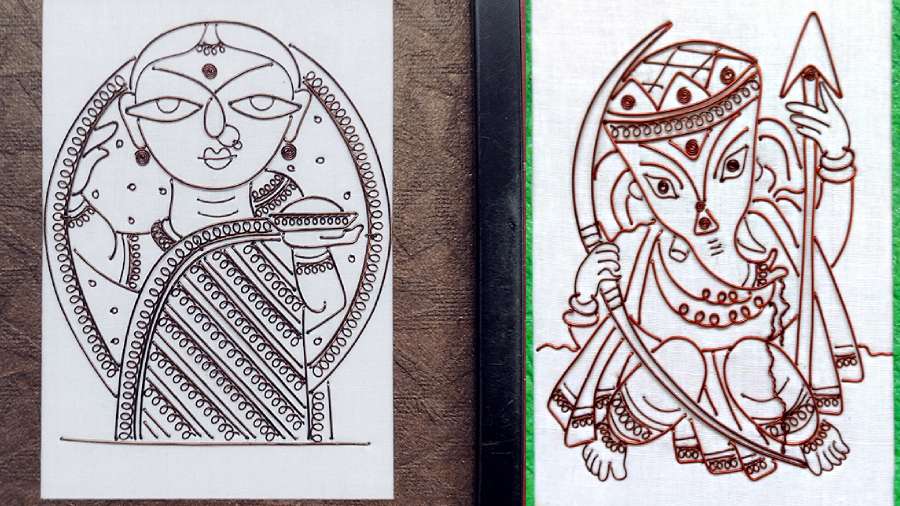At first glance, it looks like a line drawing, an intricate one at that, modelled on Jamini Roy’s Ganesh Janani — Durga with baby Ganesh on her lap — on a 6x4 inch piece of cardstock. It is one of a series of similar artworks displayed at a stall in an artisans’ exhibition-cum-sale at a banquet hall close to Kestopur on VIP Road in northwest Calcutta. The exhibition is being held to mark Unesco’s recognition of Calcutta’s Durga Puja and every item on display — from earrings to bags to coasters to clothes — features Ma Durga or her children or their respective celestial mounts.
The stall selling what appears to be framed line drawings mounted on handmade paper has on display Ganesh in six different styles, Durgas large and small, ornamented and armed or simply clad with a child on her lap.
A closer look reveals that these are no mere scratches of pen on paper, the lines are formed by fine copper wires and the cardstock is actually a stiff piece of cardboard covered in white cloth. The man selling them is also the one who made them and he has come all the way from a village called Halshidanga near Bolpur.
Pradip Kumar Mandal refuses to accept any compliments for his artistry. “I can’t draw at all. I could never draw these figures. This is just craftsmanship,” he says.

Durga and Ganesh figures Mandal has created with copper wires.
Crafting each of these exquisite pieces starts with taking printouts of those sketches he so admires. The paper is pinned to the cloth-covered board and Mandal gets to work, armed with pliers, wire and cutter. He plunges pieces of wire through the paper and board, aligns them to the lines of the sketch and ties the ends with twists of the pliers.
The ornamentation is really loops of the wire. Straight lines, curved lines, loops and filled circles are the only shapes he can employ.
Mandal talks about one of the largest pieces he recently made: “Two siblings brought me a large photograph of their parents to turn into copper wire work. It was their 50th wedding anniversary and the children wanted to gift them something special.” It took him 15-20 days to execute their request.
Each 6x4 piece takes Mandal four to five hours. He says, “I can’t move the leg I am resting the cardboard on for that whole time. I can’t even shift legs.” After he completes the design, he tears off the sketch he was working on, then turns the artwork — craftwork? — over and beats the copper ties on the back flat. He mounts it on handmade paper and frames it himself. He sells each of these pieces that he has worked on for hours for Rs 350.
Unlike most artisans, Mandal did not learn copper wire work from his father. What he did learn was farming; Mandal senior owns about seven bighas of land.
Soon after his daughter was born, Mandal junior realised that cultivating his land was not enough to sustain a family of four. So he handed over the fields to a sharecropper. “We pay all the costs and we get two-thirds while he gets onethird,” he says.
Next, he headed to the workshop of a man in the next village who knew the art of copper wire twisting. That was a decade ago and he spent half of those intervening years working for his teacher. “He gave me the materials and the sketches and paid me for each piece I made,” Mandal says.
It was barely enough. So every weekend, Mandal went to what was then the weekly haat at Khoai in Bolpur to sell his ware. Eventually, he started getting orders too and he was able to quit his poorly-paid work. “Manjusha (the West Bengal government emporium) wanted me to supply them with my work but I had to turn them down. I did not have the capital to make the work in quantities that they wanted; I would need to employ people for it. So I recommended that they contact my teacher,” he says without regrets.
Then came the pandemic. The haat closed down and Mandal’s earnings were on pause. It was during this time that his second daughter was born, with a cleft palate that needs medical attention. The family was barely managing two square meals a day when Mandal met a man who was organising fairs for artisans all over Bengal — the reason Mandal is in town.
His earnings now are a little steadier, from crafts fairs and from the Sonajhuri haat in Khoai that has reopened. The first of a series of surgeries that his young daughter needs to correct her disfigurement is done. The next one is scheduled for December.
Mandal has a glow about him when he talks about his daughters. His eldest is 12. “She is quite a talented artist,” he says proudly. “If she likes, if she is good enough, I’d like for her to study in Visva-Bharati,” says the man who never made it to college.
Photographs by Paromita Sen











